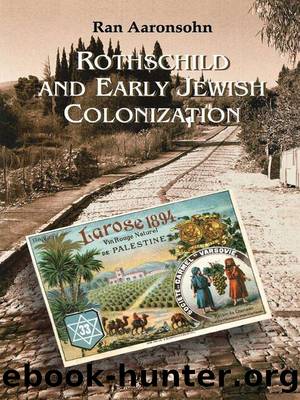Rothschild and Early Jewish Colonization in Palestine (Geographical Perspectives on the Human Past) by Ran Aaronsohn

Author:Ran Aaronsohn [Aaronsohn, Ran & Aaronsohn, Ran]
Language: eng
Format: epub, pdf
Publisher: Rowman & Littlefield Publishers
Published: 2000-10-03T22:00:00+00:00
âThe administratorsâ streetâ in Zikhron Yaâakov (aerial photo, c. 1947)
In some colonies, the streets developed around specific functions, such as administration, services, commerce, and industry, which determined the subsequent use of land on that street. This was most obvious in the larger colonies where Rothschildâs public buildings and offices were clustered in a particular area. As the bureaucratic mechanism grew, a class-oriented social hierarchy emerged that was accentuated by spatial differentiation. In Zikhron Yaâakov and Rosh Pinna, officials and farmers lived on separate streets. Yet even in those colonies where the social hierarchy was invisible to the eye, or non-existent in the 1880s, the service and administrative center was unmistakable. In Ekron, the two public buildings â a two-storey administration house and a three-storey synagogue and school â were the tallest structures in the colony, dominating the center of the colonyâs one street. This was true in nearly all the colonies including Gedera, albeit on a smaller scale. 352
Industrial buildings also tended to be consigned to a separate zone. Two out of three factories operating in the colonies in 1890 were outside the residential area. The winery in Rishon le-Zion was the built in a new site on the colony outskirts, and this was the plan for the Zikhron Yaâakov winery and flour mill. For obvious reasons, both were situated near the main approach road. The only colony with a winery in the center of town was Petah Tikva (the Nahalat Zvi winery on the Lahman estate). Interestingly, the factories built by the Rothschild administration over the next decade in Yesud ha-Ma'ala and Rosh Pinna were also zoned separately, whereas those built by Hovevei Zion in Gedera and Rehovot were not.
Shops and businesses that opened before 1890 were not set apart in a commercial quarter. We know of business ventures operating temporarily out of a room in a private home in at least eight settlements. The hotels and resort facilities offered in a few of the colonies were located in the residential neighborhood, though always in a central spot not far from the public services. Neither was any special district created for the markets that opened in the larger colonies in the second half of the 1880s. 353
Tracts of land which remained vacant in the main colonies were turned into attractive public parks. In Rishon le-Zion, the land beside the plant nursery (which was used for agricultural experimentation and later became an orchard) was developed into a park. The same was true for the vacant lot at the end of the âpublic service streetâ in Zikhron Yaâakov, and the land near the administration house in Rosh Pinna. 354 In these last two colonies, the public park was in the administrative quarter, whereas in Rishon le-Zion, it was in the residential neighborhood.
Another conspicuous feature of the colonies was the network of fences and enclosures that separated between the parcels of land and circumscribed the colony as a whole. Inside the colony, the boundaries were usually defined by rough stone walls reaching the height of a man.
Download
Rothschild and Early Jewish Colonization in Palestine (Geographical Perspectives on the Human Past) by Ran Aaronsohn.pdf
This site does not store any files on its server. We only index and link to content provided by other sites. Please contact the content providers to delete copyright contents if any and email us, we'll remove relevant links or contents immediately.
Chaco's Northern Prodigies : Salmon, Aztec, and the Ascendancy of the Middle San Juan Region after AD 1100 by Paul F. Reed(355)
Law Enforcement Interpersonal Communication and Conflict Management by Brian Douglas Fitch(347)
Digital International Relations by Unknown(346)
Critical Perspectives on Human Security : Rethinking Emancipation and Power in International Relations by David Chandler; Nik Hynek(329)
Skilled interpersonal communication: Research, theory and practice, Fifth edition by Owen Hargie(327)
The Enduring Color Line in U.S. Athletics by Krystal Beamon Chris M. Messer(325)
Evidence-Based Policy Making in Labor Economics by Hamermesh Daniel S.;Nottmeyer Olga K.;Nottmeyer Olga;King Sarah;King Sarah;King Sarah;(298)
EPSO CAST Political affairs EU policies: How to succeed in the selection procedure by Franco Reverte José María(290)
Writing Public Policy - A Practical Guide to Communicating in the Policy Making Process by Catherine F. Smith(272)
Criminological Theory in Context by John Martyn Chamberlain(270)
Tibeton Yoga Its Secret Doc by Evans-Wentz(267)
Threshold Concepts in Women's and Gender Studies by Christie Launius Holly Hassel(264)
Rothschild and Early Jewish Colonization in Palestine (Geographical Perspectives on the Human Past) by Ran Aaronsohn(263)
Positive Psychology and Spirituality in Counselling and Psychotherapy (Conflict, Ethics, and Spirituality, 12) by unknow(261)
Social Problems, Social Issues, Social Science by James Wright(259)
Play in child development and psychotherapy: toward empirically supported practice by Sandra W. Russ(254)
Cognitive Development in Infancy and Childhood (Elements in Child Development) by Mary Gauvain(252)
Latin American Politics and Society by Gerardo L. Munck & Juan Pablo Luna(224)
What Makes a Social Crisis?: The Societalization of Social Problems by Jeffrey C. Alexander(220)
